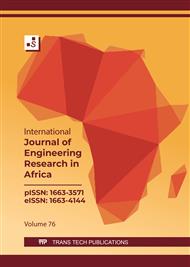[1]
ICOLD. Tailings dam safety. Preliminary draft confidential issued for internal discussion, uncontrolled document until published, (2020).
Google Scholar
[2]
ICOLD, Improving Tailings Dam Safety, Critical Aspects of Management, Design, Operation and Closure. Bulletin 139, International Commission on Large Dams-United Nations Environmental Programme, Draft December 11, (2006)
DOI: 10.1680/dare.14.00018
Google Scholar
[3]
F. Otieno, S. K. Shukla, How does mine tailings slurry solids concentration affect stability of dam embankment slope? International Journal of Mining, Reclamation and Environment. (2024), 38(4), 245-262
DOI: 10.1080/17480930.2024.2305517
Google Scholar
[4]
F.D. Popescu, S.M. Radu, A.Andras, I. Brinas, M. O. Marita, M. A. Radu, C. Brinas, Stability Assessment of the Dam of a Tailings Pond Using Computer Modeling. Case Study: Coroiești, Romania." Applied Sciences. 14.1, (2023), 268
DOI: 10.3390/app14010268
Google Scholar
[5]
R.A.C. Luna, L.A.B. Morillo, J.M.I. Tanap, M.A.H. Zarco, Geotechnical and Seismic Design Considerations for Mine Tailings Dam. In Proceedings of the 7th International Conference on Geotechnical and Geophysical Site Characterization. (2020), (pp.1419-1424). Springer
DOI: 10.1007/978-981-15-2184-3_108
Google Scholar
[6]
H. Karoui, H. Maazoun, M. Bouassida, Numerical simulation of wet deposited Phosphogypsum embankment resting on dry deposited one. Arabian Journal of Geosciences, (2020), 13, 1-11
DOI: 10.1007/s12517-020-05783-z
Google Scholar
[7]
S. Singh, A. Kumar, T. G. Sitharam, Stability analysis of tailings dam using finite element approach and conventional limit equilibrium approach. In: Satyanarayana Reddy, C.N.V., Muthukkumaran, K., Vaidya, R. (eds) Stability of Slopes and Underground Excavations. Lecture Notes in Civil Engineering. (2022), vol 185. Springer, Singapore
DOI: 10.1007/978-981-16-5601-9_9
Google Scholar
[8]
K, Verreydt, Design parameters for construction of dikes with treated sludge at redevelopment of sludge reservoirs. (2021)
Google Scholar
[9]
T. M. Do, J. Laue, H. Mattsson, Q. Jia, Numerical Analysis of an Upstream Tailings Dam Subjected to Pond Filling Rates. Applied Sciences. (2021), 11(13), 6044
DOI: 10.3390/app11136044
Google Scholar
[10]
L. Hassellund, R. Knutsson, H. Mattsson, S. Knutsson, Numerical Simulations of Stability of a Gradually Raised Upstream Tailings Dam in Northern Sweden. The Electronic Journal of Geotechnical Engineering. (2016), 21(16), 5595-5608.
Google Scholar
[11]
M. Li, L. Liang, X. Li, Comparison analysis among different calculation methods for the static stability evaluation of tailing dam. Proceedings of the 10th World Congress on Computational Mechanics, (2014)
DOI: 10.5151/MECENG-WCCM2012-20182
Google Scholar
[12]
O. Radchuk, Slope Stability Assessment of Tailings Dam. Key Engineering Materials. (2024), 969, 123-132
DOI: 10.4028/p-mhh85g
Google Scholar
[13]
X. Lu, X.Chang, Stability Analysis of Tailings Dam based on the Combination of Seepage and Stress. Journal of Physics: Conference Series. (2019), 1168(2), 022067
DOI: 10.1088/1742-6596/1168/2/022067
Google Scholar
[14]
K. Chand, V. Kumar, P. Raj, N. Sharma, A. K. Mankar, R. Koner, Artificial Intelligence Tool for Prediction of Mine Tailings Dam Slope Stability. Journal of Mining and Environment,. (2024), 15(3), 1023-1038
Google Scholar
[15]
D.M. Eneyew, T.H. Gugsa, Numerical stability analysis on the selected reservoir slopes of Ajima Earthen Dam, Central Ethiopia. Modeling Earth Systems and Environment. (2025), 11(30), 4567-4582
DOI: 10.1007/s40808-024-02258-y
Google Scholar
[16]
M. Diyora, A Comparative Study on the Stability Analysis of Tailings Pond Embankments Under Transient and Steady-State Seepage Conditions. In Proceedings of the Indian Geotechnical Conference. (2023), (pp.365-376). Springer
DOI: 10.1007/978-981-19-7245-4_32
Google Scholar
[17]
A.R. Borujerdi, Seismic Stability and Liquefaction Analysis of Tailings Slope. Journal of Civil Engineering. (2022), 3(01), 25-33.
DOI: 10.38094/jocef30148
Google Scholar
[18]
D. Reid, A. Fourie, Development and outcomes of a tailings slope stability comparative design exercise. Canadian Geotechnical Journal, 4 June 2024, 61(8), 1683-1704
DOI: 10.1139/cgj-2022-0065
Google Scholar
[19]
Z. Chen, C. Junrui, C. Jing, X. Zengguang, Q. Yuan, L.V. Zongjie, Numerical simulation of seepage and stability of tailings dams: a case study in Lixi, China. Water. (2020), Vol 12, 742;
DOI: 10.3390/w12030742
Google Scholar
[20]
A. L. B. Cavalcante, A. P. Assis, Effect of Nonhomogenity of permeability on tailings dams. International Journal of surface mining reclamation and environment. International Journal of Surface Mining, Reclamation and Environment. (2010), Vol 16, 314-330
DOI: 10.1076/ijsm.16.4.314.8634
Google Scholar
[21]
D. Chatterjee, A. Murali Krishna, Effect of Slope Angle on the Stability of a Slope Under Rainfall Infiltration. Indian Geotech J 49. (2019), 708–717
DOI: 10.1007/s40098-019-00362-w
Google Scholar
[22]
J. Yang, J. Hu, Y. Wu, B. Zhang, Numerical Simulation of Seepage and Stability of Tailing Dams: A Case Study in Ledong, China. Sustainability. (2022), 14(19), 12393
DOI: 10.3390/su141912393
Google Scholar
[23]
L. Zhang, F. Li, C. Peng, Stability Analysis of Tailings Dam Based on Coupling Seepage and Stress. In Proceedings of the 2016 International Conference on Advanced Electronic Science and Technology. (2017), (pp.408-413). Atlantis Press
DOI: 10.2991/AECE-16.2017.88
Google Scholar
[24]
F. Kang, G. Wang, Y. Li, B. Cai, S. Li, L. Zhao, X. Li, Analysis of the Dynamic Stability of Tailing Dams: An Experimental Study on the Dynamic Characteristics of Tailing Silt. Appl. Sci. (2023), 13, 5250
DOI: 10.3390/app13095250
Google Scholar
[25]
G. Cao, W. Wang, G. Yin, Z. Wei, Experimental study of shear wave velocity in unsaturated tailings soil with variant grain size distribution. Construction and Building Materials, (2019), 228
DOI: 10.1016/j.conbuildmat.2019.116744
Google Scholar
[26]
A.J. Hawk, Simulating 3D Tailings Dam Breach With Thixotropic Bifurcation Rheology using the Material Point Method. Electronic Thesis and Dissertation Repository, (2023)
DOI: 10.22215/etd/2023-15438
Google Scholar


